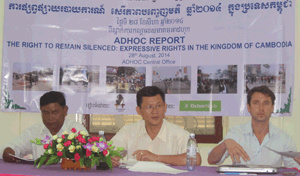In July 2008, ADHOC received 17 cases of land conflicts from people all over the country. Most of the cases are likely to involve high-ranking government authorities such as police, soldiers, village and commune chiefs and especially private investment companies. All of these cases, the conflict was over 802 ha of land, and affecting 781 families. We have noticed that most of the cases of land conflict took place in provinces of Siemreap, Kratie, and Preahvihear. Siemreap province is the only one province that is much more affected than others. Most of the disputed land are farmland, orchards and forestland, which people have cleared, managed, cultivated and lived on for a long time. And later on, the provincial authorities confiscated those areas as state-own estate and their own property.
There are 2 root causes of land conflict: Firstly, land conflict is provoked by the authorities such as village and commune chiefs, police, especially soldiers and other state institutions, which used their role and power excessively to confiscate people’s land, and secondly, it is a consequence of economic land concession granted by government to both national and international investors, without prior-consultation with people of community about its negative impacts on villagers’ daily livelihoods. These cases happened quite often almost in each province of the country. That is why, we can see that the economic land concession of the government to private companies is the clear reason causing land conflict quite often . On the other hand, some grantees of economic land concession proceed to carry out their development plan by encroaching upon people’s land located nearby their estate.
Case Study:
 There was one case of land conflict taking place in Outey village Lveakraing commune, Varen district, Siemreap province. The disputed land was over 644ha , and it affected 629 families. Since 1979 until 1993, some parts of this disputed land is farm land of people and other is state forest land. Since 1993, people have started to occupy, live and grow rice on the disputed land without any prohibition until becoming 3 villages in Lveakraing commune. In 2008, there was one private company received the economic land concession right from the government in total size 2000 ha to develop the agriculture domain in that area. Until March 3, 2008, the company representative ordered their workers to cut trees and cleared the land by encroaching people’s land near their concession land. The development plan of the company on the concession land is covered 7002 ha higher than the concession plan provided by the government to the company only 2000 ha. On March 18, 2008, the company brought two cars of soldiers with guns to destroy people’s property and burn house walls of people in the threee villages while no one dare protest. The company has still occupied on the land and banned people to grow rice. The two parties still faced each other until now.
There was one case of land conflict taking place in Outey village Lveakraing commune, Varen district, Siemreap province. The disputed land was over 644ha , and it affected 629 families. Since 1979 until 1993, some parts of this disputed land is farm land of people and other is state forest land. Since 1993, people have started to occupy, live and grow rice on the disputed land without any prohibition until becoming 3 villages in Lveakraing commune. In 2008, there was one private company received the economic land concession right from the government in total size 2000 ha to develop the agriculture domain in that area. Until March 3, 2008, the company representative ordered their workers to cut trees and cleared the land by encroaching people’s land near their concession land. The development plan of the company on the concession land is covered 7002 ha higher than the concession plan provided by the government to the company only 2000 ha. On March 18, 2008, the company brought two cars of soldiers with guns to destroy people’s property and burn house walls of people in the threee villages while no one dare protest. The company has still occupied on the land and banned people to grow rice. The two parties still faced each other until now.
ADHOC has noticed that the land conflict in July has decreased a little bit if we compare with June of the same year. But there still have been thousands of families are victims of land rights violations perpetrated by high-ranking officials and private companies.
This is apparently to downgrade people’s poverty because their daily livelihoods entirely rely upon rice cultivation. Government has to take action on time to settle all cases of land conflict effectively. On the other hand, government must take serious steps to punish any officials who have violated people’s land rights in order to reduce the land conflict escalations.

